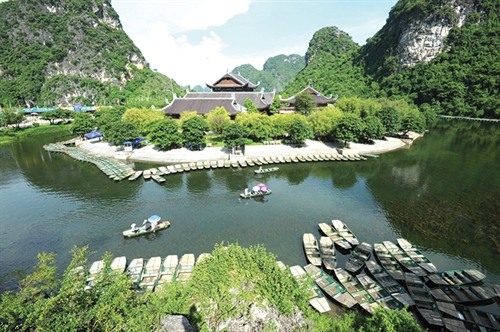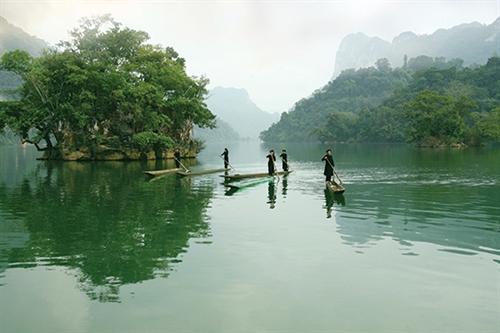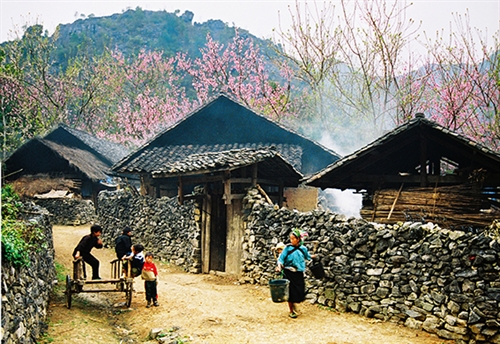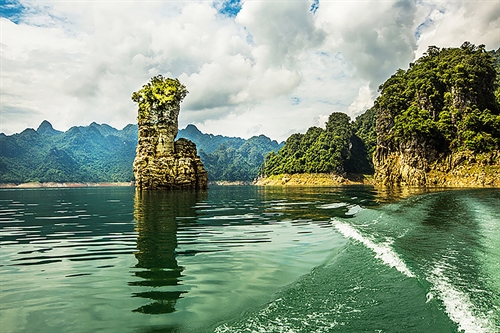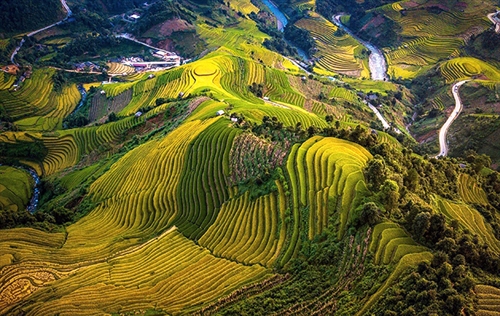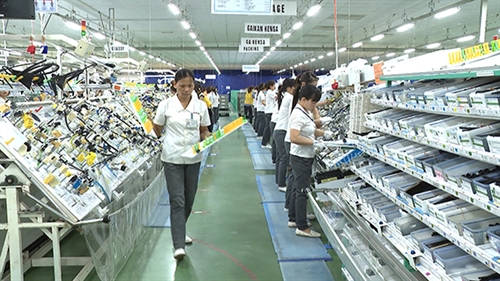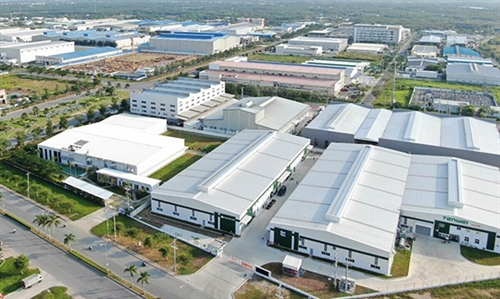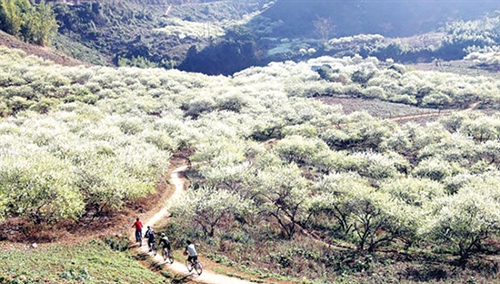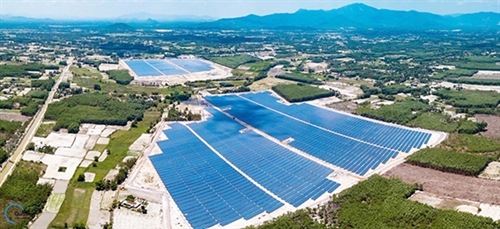An Giang, a southwestern province that shares a border of around 100 kilometers with Cambodia, is calling for investment in urban infrastructure, hi-tech agriculture and tourism in order to turn itself into a modern, smart, ecological province imbued with cultural identity of the Mekong River delta.
An Giang is bordered by Kien Giang province to the southwest, Can Tho province to the south, Dong Thap province to the east and Cambodia’s Takeo and Kandal provinces to the north and northeast. It is regarded as an important point connecting other Mekong River delta provinces and Ho Chi Minh City with Cambodia as well as other ASEAN countries via two international border gates of Tinh Bien in Tinh Bien district and Vinh Xuong in Tan Chau town, and national Khanh Binh border gate and auxiliary Vinh Hoi Dong border gate in An Phu district.
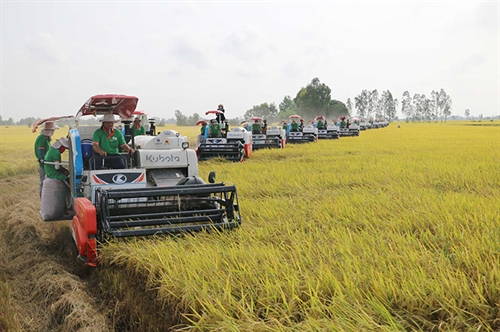 |
| Harvesting rice in Thoai Son district__Photo: Cong Mao/VNA |
An Giang province boasts unique characteristics with plains, hilly forests, and historical sites revealing the marks of the ancient wet-rice cultivation. It has a dense network of rivers and canals convenient for rice production, waterway transportation and aquaculture. The province is currently the country’s second largest rice producer (following Kien Giang province) with an annual output of some four million tons and rice export quantity of between 500,000-550,000 tons worth around USD 250 million.
To attract investment in the three above-mentioned spheres, the province has taken solutions to improve its business and investment environment. One of those solutions is speeding up the implementation of key construction projects, including construction of a 17.3 km provincial road section connected to national highway No. 91 and Long Xuyen city bypass road. The road starts at the intersection with provincial road 921 in Thot Not district of Can Tho city, and ends in front of Can Xay Church in Long Xuyen city of An Giang province. The road will help ease the traffic congestion and facilitate inter-provincial transportation of goods once it is completed.
The Chau Doc-Can Tho-Soc Trang expressway section running through the province is expected to be built on April 30 next year. The 188.2 km expressway starts from the junction with national highway No. 91 in Chau Doc city (An Giang province), running through Can Tho city and Hau Giang province, and ends at Tran De port (Soc Trang province), all in the Mekong River delta. In the province, the 57.2 km section starts in Chau Doc city and intersects provincial roads 945, 941 and 943 in districts of Chau Phu, Chau Thanh and Thoai Son.
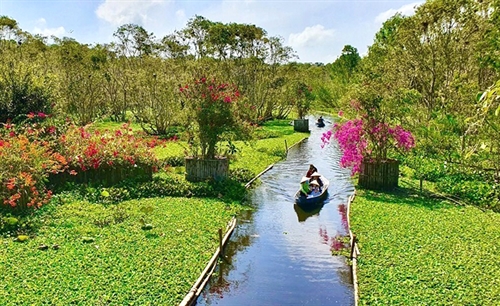 |
| Tra Su cajuput forest in Tinh Bien district__Photo: Thanh Sang/VNA |
Apart from the transport infrastructure construction, An Giang has exerted its efforts to move up two places in the 2021 provincial competitiveness index (PCI) ranking. With a score of 66.48 points, it is now ranked 17th among 63 provinces and cities nationwide or fourth among 13 provinces and cities in the Mekong River delta. To further raise its score and PCI ranking, the provincial authorities have determined to simplify and shorten the time to process administrative procedures, particularly those for investment and tax break.
The provincial authorities have regularly hosted business dialogues with enterprises, cooperatives and business households to address difficulties and remove obstacles in the fields of construction, taxation, labor, salary, insurance, transport, trade, services, healthcare, finance and agriculture. Thanks to those efforts, the province recorded an economic growth rate of 2.15 percent in 2021 despite the impacts of the COVID-19 pandemic.
To facilitate investors’ production and business activities, the provincial authorities always offer special incentives on land rental and corporate income tax to investment projects. Accordingly, investors in agriculture and rural areas will enjoy land rental exemption for up to three years during the capital construction of their projects. For investment projects on construction and commercial operation of infrastructure facilities in IPs, industrial clusters, export processing zones, economic zones and hi-tech parks on land areas leased by the State in localities with particularly difficult socio-economic conditions, investors will be exempted from land rental for 11 years after enjoying land rental exemption for projects’ capital construction. Meanwhile, investors building worker dormitories will be exempted from land or water surface rental during the lease period. Investors in agriculture that implement projects eligible for special investment incentives will be exempted from land and surface water rental for land or surface water areas allocated by the State. For enterprises having agriculture projects eligible for investment incentives or investment promotion, land or water surface rental will be exempted for the first 15 or 11 years of operation and entitled to 50 percent reduction for seven or five subsequent years. Investors that invest in Xuan To and Hoi An industrial parks and expanded Binh Hoa and Binh Long industrial parks will enjoy corporate income tax exemption for four years and 50-percent reduction for the subsequent nine years.
Deputy director of the An Giang Planning and Investment Department Trang Cong Cuong told the Vietnam Law and Legal Forum magazine that his province has so far this year licensed two foreign direct investment (FDI) projects worth USD 23 million in total. At present, the province houses 40 FDI projects with a combined registered capital of USD 305.9 million with 22 projects worth more than USD 259.3 million specialized in industries, 16 projects worth USD 38.3 million in trade and services, and two projects worth USD 8.1 million in agriculture. Its FDI came from 18 countries and territories.
The province has worked out a tourism infrastructure development program for the 2021-25 period that aims at turning hospitality into a key economic sector and welcoming 42 million tourist arrivals, including 4.6 million this year, and earning VND 27.8 trillion.
To achieve that target, the hospitality sector will develop a trademark to meet visitors’ needs and its official website, and use the social media to advertise the local image, landscapes and cuisine.
The province will develop spiritual-ecological-recreational tours and cross-border tours to Cambodia, Laos, Thailand, Japan and the Republic of Korea. It will set up travel agent offices in Ho Chi Minh City, Hanoi, Da Nang and countries bordering Cambodia in order to introduce provincial tourist products.
To create a safe, civilized and friendly environment for holidaymakers, the province will establish a tourist support center, operate a travel helpline and launch a tourism campaign touting every citizen as a tour guide in tourist attractions across the province.-
| Provincial facts Land area: 3,424 sq. km Administrative units: Long Xuyen and Chau Doc cities, Tan Chau town and eight districts of Cho Moi, Phu Tan, Chau Thanh, Chau Phu, Thoai Son, Tri Ton, Tinh Bien and An Phu Population: more than 2.1 million Ethnic minority groups: 28 ethnic minority groups with some 119,210 people, mainly the Khmer, Cham and Hoa Socio-economic figures: - Export turnover: over USD 956 million (in 10 months of 2022) - Key exports: rice, aquatic products, vegetables, fruits, textile and garment products - Gross regional domestic product (GRDP) growth rate: estimated to increase by 4.98 percent over the same period last year to VND 47,330 billion (in six months of 2022) - Industrial parks: Binh Hoa on 132 hectares in Chau Thanh district; Binh Long on 30.57 hectares in Chau Phu district, and Xuan To on 57.4 hectares in Tinh Bien district - Industrial clusters: My Quy and Binh Duc in Long Xuyen city; Vinh Binh in Chau Thanh district; Vinh My in Chau Doc city, Long Chau in Tan Chau town, An Phu in the same-name district, Luong An Tra in Tri Ton district, Tan Trung in Phu Tan district, and Phu Hoa in Thoai Son district Tourism: - Must-see tourist attractions: + Long Xuyen floating market + Oc Eo-Ba The archaeological site - a special national relic site + Tra Su cajuput forest with 140 plant species, 70 bird species, 11 mammal species, 25 reptile species and 23 fish species + Ba Chua Xu or local tutelary goddess Temple + Truc Lam An Giang Zen Monastery + 1,500-hectare Sam Mountain National Tourism Zone - Craft villages: Chau Giang (brocade weaving) of the Cham; Tan Chau (silk weaving); My Hoa (fish hook making); Binh Duc (incense making); Cho Thu (carpentry); An Phu (palm-sugar making) - Tourists received: 7 million (including 6,000 foreign holidaymakers) in 10 months of 2022 - Tourist accommodations: 95 hotels and guest houses and 16 homestays - Festivals: + Ba Chua Xu Festival (a national intangible heritage) + Bay Nui or Seven Mountains Ox Racing Festival + Sene Dolta festival - an annual ritual to worship the Khmer ancestors + Chol Chnam Thmay festival - traditional New Year festival of the Khmer + Roya Haji festival - traditional New Year Festival of the Cham + Ooc Oom Bok festival of the Khmer to honor the moon for a bumper harvest (Source: https://sokhdt.angiang.gov.vn; https://sovhttdl.angiang.gov.vn; and https://www.angiang.gov.vn) |
